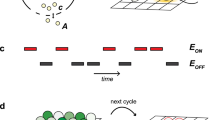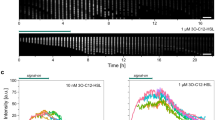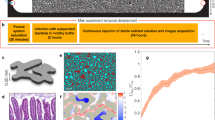Abstract
Many reports have elucidated the mechanisms and consequences of bacterial quorum sensing (QS), a molecular communication system by which bacterial cells enumerate their cell density and organize collective behavior. In few cases, however, the numbers of bacteria exhibiting this collective behavior have been reported, either as a number concentration or a fraction of the whole. Not all cells in the population, for example, take on the collective phenotype. Thus, the specific attribution of the postulated benefit can remain obscure. This is partly due to our inability to independently assemble a defined quorum, for natural and most artificial systems the quorum itself is a consequence of the biological context (niche and signaling mechanisms). Here, we describe the intentional assembly of quantized quorums. These are made possible by independently engineering the autoinducer signal transduction cascade of Escherichia coli (E. coli) and the sensitivity of detector cells so that upon encountering a particular autoinducer level, a discretized sub-population of cells emerges with the desired phenotype. In our case, the emergent cells all express an equivalent amount of marker protein, DsRed, as an indicator of a specific QS-mediated activity. The process is robust, as detector cells are engineered to target both large and small quorums. The process takes about 6 h, irrespective of quorum level. We demonstrate sensitive detection of autoinducer-2 (AI-2) as an application stemming from quantized quorums. We then demonstrate sub-population partitioning in that AI-2-secreting cells can ‘call’ groups neighboring cells that ‘travel’ and establish a QS-mediated phenotype upon reaching the new locale.
Similar content being viewed by others
Log in or create a free account to read this content
Gain free access to this article, as well as selected content from this journal and more on nature.com
or
References
Balestrino D, Haagensen JAJ, Rich C, Forestier C . (2005). Characterization of type 2 quorum sensing in Klebsiella pneumoniae and relationship with biofilm formation. J Bacteriol 187: 2870–2880.
Bassler BL, Wright M, Silverman MR . (1994). Multiple signalling systems controlling expression of luminescence in Vibrio harveyi: sequence and function of genes encoding a second sensory pathway. Mol Microbiol 13: 273–286.
Ben-Jacob E, Becker I, Shapira Y, Levine H . (2004). Bacterial linguistic communication and social intelligence. Trends Microbiol 12: 366–372.
Ben-Jacob E, Schultz D . (2010). Bacteria determine fate by playing dice with controlled odds. Proc Natl Acad Sci USA 107: 13197–13198.
Betz JL, Sasmor HM, Buck F, Insley MY, Caruthers MH . (1986). Base substitution mutants of the lac operator: in vivo and in vitro affinities for lac repressor. Gene: Netherlands 50: 123–132.
Connell JL, Whiteley M, Shear JB . (2012). Sociomicrobiology in engineered landscapes. Nat Chem Biol 8: 10–13.
Dandekar AA, Chugani S, Greenberg EP . (2012). Bacterial quorum sensing and metabolic incentives to cooperate. Science 338: 264–266.
Danino T, Mondragon-Palomino O, Tsimring L, Hasty J . (2010). A synchronized quorum of genetic clocks. Nature 463: 326–330.
Datsenko KA, Wanner BL . (2000). One-step inactivation of chromosomal genes in Escherichia coli K-12 using PCR products. Proc Natl Acad Sci USA 97: 6640–6645.
Davidson CJ, Surette MG . (2008). Individuality in bacteria. Annu Rev Genet 42: 253–268.
Defoirdt T . (2011). Can bacteria actively search to join groups? ISME J 5: 569–570.
DeLisa MP, Valdes JJ, Bentley WE . (2001a). Quorum signaling via Al-2 communicates the ‘metabolic burden’ associated with heterologous protein production in Escherichia coli. Biotechnol Bioengineer 75: 439–450.
DeLisa MP, Valdes JJ, Bentley WE . (2001b). Mapping stress-induced changes in autoinducer AI-2 production in chemostat-cultivated Escherichia coli K-12. J Bacteriol 183: 2918–2928.
DeLisa MP, Wu CF, Wang L, Valdes JJ, Bentley WE . (2001c). DNA microarray-based identification of genes controlled by autoinducer 2-stimulated quorum sensing in Escherichia coli. J Bacteriol 183: 5239–5247.
Dulla G, Lindow SE . (2008). Quorum size of Pseudomonas syringae is small and dictated by water availability on the leaf surface. Proc Natl Acad Sci USA 105: 3082–3087.
Federle MJ, Bassler BL . (2003). Interspecies communication in bacteria. J Clin Invest 112: 1291–1299.
Fernandes R, Roy V, Wu HC, Bentley WE . (2010). Engineered biological nanofactories trigger quorum sensing response in targeted bacteria. Nat Nanotechnol 5: 213–217.
Fuqua C, Greenberg EP . (1998). Self perception in bacteria: quorum sensing with acylated homoserine lactones. Curr Opin Microbiol 1: 183–189.
Fuqua WC, Winans SC, Greenberg EP . (1994). Quorum sensing in bacteria: the LuxR-LuxI family of cell density-responsive transcriptional regulators. J Bacteriol 176: 269–275.
Gantner S, Schmid M, Durr C, Schuhegger R, Steidle A, Hutzler P et al. (2006). In situ quantitation of the spatial scale of calling distances and population density-independent N-acylhomoserine lactone-mediated communication by rhizobacteria colonized on plant roots. FEMS Microbiol Ecol 56: 188–194.
Gardner A, West SA, Griffin AS . (2007). Is bacterial persistence a social trait? PLoS One 2: e752.
Gonzalez Barrios AF, Zuo R, Hashimoto Y, Yang L, Bentley WE, Wood TK . (2006). Autoinducer 2 controls biofilm formation in Escherichia coli through a novel motility quorum-sensing regulator (MqsR, B3022). J Bacteriol 188: 305–316.
Gupta A, Terrell JL, Fernandes R, Dowling MB, Payne GF, Raghavan SR et al. (2013). Encapsulated fusion protein confers ‘sense and respond’ activity to chitosan-alginate capsules to manipulate bacterial quorum sensing. Biotechnol Bioengineer 110: 552–562.
Ha JH, Eo Y, Grishaev A, Guo M, Smith JA, Sintim HO et al. (2013). Crystal structures of the LsrR proteins complexed with phospho-AI-2 and two signal-interrupting analogues reveal distinct mechanisms for ligand recognition. J Am Chem Soc 135: 15526–15535.
Hegde M, Englert DL, Schrock S, Cohn WB, Vogt C, Wood TK et al. (2011). Chemotaxis to the quorum-sensing signal AI-2 requires the Tsr chemoreceptor and the periplasmic LsrB AI-2-binding protein. J Bacteriol 193: 768–773.
Hense BA, Kuttler C, Muller J, Rothballer M, Hartmann A, Kreft JU . (2007). Does efficiency sensing unify diffusion and quorum sensing? Nat Rev Microbiol 5: 230–239.
Herzberg M, Kaye IK, Peti W, Wood TK . (2006). YdgG (TqsA) controls biofilm formation in Escherichia coli K-12 through autoinducer 2 transport. J Bacteriol 188: 587–598.
Hooshangi S, Bentley WE . (2011). LsrR quorum sensing ‘switch’ is revealed by a bottom-up approach. PLoS Comp Biol 7: e1002172.
Li J, Attila C, Wang L, Wood TK, Valdes JJ, Bentley WE . (2007). Quorum sensing in Escherichia coli is signaled by AI-2/LsrR: effects on small RNA and biofilm architecture. J Bacteriol 189: 6011–6020.
Luo X, Wu HC, Tsao CY, Cheng Y, Betz J, Payne GF et al. (2012). Biofabrication of stratified biofilm mimics for observation and control of bacterial signaling. Biomaterials 33: 5136–5143.
Maniatis T, Fritsch EF, Sambrook J . (1982) Molecular Cloning: A Laboratory Manual. Cold Spring Harbor Laboratory: Cold Spring Harbor, : NY.
Mok KC, Wingreen NS, Bassler BL . (2003). Vibrio harveyi quorum sensing: a coincidence detector for two autoinducers controls gene expression. EMBO J 22: 870–881.
Parsek MR, Greenberg EP . (2005). Sociomicrobiology: the connections between quorum sensing and biofilms. Trends Microbiol 13: 27–33.
Pradhan BB, Chatterjee S . (2014). Reversible non-genetic phenotypic heterogeneity in bacterial quorum sensing. Mol Microbiol 92: 557–569.
Quan DN, Bentley WE . (2012). Gene network homology in prokaryotes using a similarity search approach: queries of quorum sensing signal transduction. PLoS Comp Biol 8: e1002637.
Schauder S, Shokat K, Surette MG, Bassler BL . (2001). The LuxS family of bacterial autoinducers: biosynthesis of a novel quorum-sensing signal molecule. Mol Microbiol 41: 463–476.
Siegele DA, Hu JC . (1997). Gene expression from plasmids containing the araBAD promoter at subsaturating inducer concentrations represents mixed populations. Proc Natl Acad Sci USA 94: 8168–8172.
Smith R, Tan C, Srimani JK, Pai A, Riccione KA, Song H et al. (2014). Programmed Allee effect in bacteria causes a tradeoff between population spread and survival. Proc Natl Acad Sci USA 111: 1969–1974.
Surette MG, Bassler BL . (1998). Quorum sensing in Escherichia coli and Salmonella typhimurium. Proc Natl Acad Sci USA 95: 7046–7050.
Swofford CA, Van Dessel N, Forbes NS . (2015). Quorum-sensing Salmonella selectively trigger protein expression within tumors. Proc Natl Acad Sci USA 112: 3457–3462.
Taga ME . (2005), Methods for analysis of bacterial autoinducer-2 production. Current protocols in microbiology Chapter 1: Unit 1C 1.
Tavender TJ, Halliday NM, Hardie KR, Winzer K . (2008). LuxS-independent formation of AI-2 from ribulose-5-phosphate. BMC Microbiol 8: 98.
Thompson JA, Oliveira RA, Djukovic A, Ubeda C, Xavier KB . (2015). Manipulation of the quorum sensing signal AI-2 affects the antibiotic-treated gut microbiota. Cell Rep 10: 1861–1871.
Tsao CY, Hooshangi S, Wu HC, Valdes JJ, Bentley WE . (2010). Autonomous induction of recombinant proteins by minimally rewiring native quorum sensing regulon of E. coli. Metabol Engineer 12: 291–297.
Ulitzur S, Yashphe J, Hastings JW . (1976). Inhibition and stimulation of the development of the bioluminescent system in Beneckea harveyi by cyclic GMP. Proc Natl Acad Sci USA 73: 4454–4456.
Vilchez R, Lemme A, Thiel V, Schulz S, Sztajer H, Wagner-Dobler I . (2007). Analysing traces of autoinducer-2 requires standardization of the Vibrio harveyi bioassay. Anal Bioanal Chem 387: 489–496.
Wang L, Hashimoto Y, Tsao CY, Valdes JJ, Bentley WE . (2005a). Cyclic AMP (cAMP) and cAMP receptor protein influence both synthesis and uptake of extracellular autoinducer 2 in Escherichia coli. J Bacteriol 187: 2066–2076.
Wang L, Li J, March JC, Valdes JJ, Bentley WE . (2005b). luxS-dependent gene regulation in Escherichia coli K-12 revealed by genomic expression profiling. J Bacteriol 187: 8350–8360.
Winzer K, Hardie KR, Burgess N, Doherty N, Kirke D, Holden MT et al. (2002). LuxS: its role in central metabolism and the in vitro synthesis of 4-hydroxy-5-methyl-3(2H)-furanone. Microbiology 148: 909–922.
Wu HC, Tsao CY, Quan DN, Cheng Y, Servinsky MD, Carter KK et al. (2013). Autonomous bacterial localization and gene expression based on nearby cell receptor density. Mol Syst Biol 9: 636.
Xavier KB, Bassler BL . (2005). Regulation of uptake and processing of the quorum-sensing autoinducer AI-2 in Escherichia coli. J Bacteriol 187: 238–248.
Yung CW, Barbari TA, Bentley WE . (2006). Integrated non-invasive system for quantifying secreted human therapeutic hIL2. Biotechnol Bioengineer 95: 938–945.
Zhu J, Miller MB, Vance RE, Dziejman M, Bassler BL, Mekalanos JJ . (2002). Quorum-sensing regulators control virulence gene expression in Vibrio cholerae. Proc Nati Acad Sci USA 99: 3129–3134.
Zhu J, Pei D . (2008). A LuxP-based fluorescent sensor for bacterial autoinducer II. ACS Chem Biol 3: 110–119.
Acknowledgements
We acknowledge support of the Defense Threat Reduction Agency (DTRA, HDTRA1-13-1-0037), the National Science Foundation (CBET 1264509 & CBET 1160005) and the RW Deutsch Foundation.
Author information
Authors and Affiliations
Corresponding author
Additional information
Supplementary Information accompanies this paper on The ISME Journal website
Supplementary information
Rights and permissions
About this article
Cite this article
Servinsky, M., Terrell, J., Tsao, CY. et al. Directed assembly of a bacterial quorum. ISME J 10, 158–169 (2016). https://doi.org/10.1038/ismej.2015.89
Received:
Revised:
Accepted:
Published:
Issue date:
DOI: https://doi.org/10.1038/ismej.2015.89
This article is cited by
-
Bioelectronic control of a microbial community using surface-assembled electrogenetic cells to route signals
Nature Nanotechnology (2021)
-
Bacterial co-culture with cell signaling translator and growth controller modules for autonomously regulated culture composition
Nature Communications (2019)
-
Regulation of bacteria population behaviors by AI-2 “consumer cells” and “supplier cells”
BMC Microbiology (2017)
-
Electronic control of gene expression and cell behaviour in Escherichia coli through redox signalling
Nature Communications (2017)
-
Nano-guided cell networks as conveyors of molecular communication
Nature Communications (2015)



